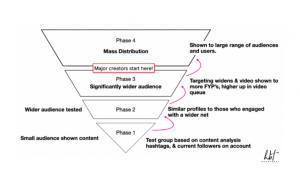TikTok: The Platform of Opportunity. How TikTok Challenges the Concept of Endorsements on the Web.
How TikTok’s recommendation algorithm works against the algorithms commonly used by other social media platforms–thus, giving smaller accounts a chance. This article provides a thorough explanation of TikTok’s recommendation algorithm so that influencers and marketers can understand the platform better and subsequently gain more popularity.
The Algorithm
TikTok utilizes an algorithm that refines its content recommendation system so that users are able to have a more personalized experience with the app. The algorithm starts out as binary (like or dislike) and is broken down into three smaller factors: user interaction, video information, and device and account settings. User interaction consists of how the audience is (or isn’t) interacting with the content–i.e. Likes, shares, comments, etc. Video information involves the content itself–i.e. Hashtags, audio used, and captions. The last, and least significant, factor is concerned with region, language, and phone type. It is important to note that some factors are weighted more heavily than others.
Below is a simple diagram of how smaller accounts can achieve upward mobility.
The Opportunity
TikTok distinguishes itself from other platforms due to users’ ability to spontaneously go viral. The platform emphasizes that follower count does not directly play a role in the recommendation system. Of course, accounts with a larger following will inherently get more user interaction, but a higher following does not mean an upper-hand in the recommendation system. In contrast, Instagram will regurgitate content created by accounts that are already very large–you’re less likely to be recommended content created by smaller accounts even if it might interest you. Instagram and platforms alike keep the “rich get richer” saying alive by allowing these sorts of monopoly accounts to continue thriving. TikTok promotes discovery which makes users feel more encouraged to create content and keeps the platform alive.
Relation to Course
We learned to assess a page’s value (relative to a query) through their in-links. All of these in-link pages (hubs) act as endorsements for other pages (authorities). In addition, we agreed that hubs should be weighted differently, especially if they’re “good” hubs–they link to the most relevant pages only. So the hubs endorse the authorities and the authorities endorse the hubs thus, we established a mental model of the Web “ecosystem”. This balance is known as the Principle of Repeated Improvement. Now think of these hubs and authorities as Instagram accounts (personal or business accounts). We can think of the “votes” as likes in the context of social media. The accounts receive their endorsements either through shoutouts from other popular accounts or constantly being featured on the discovery page. The issue with this, however, is that the same popular accounts keep endorsing/ getting endorsed by the same other popular accounts which accrue even more likes for those already highly-liked pages. The rich-get-richer phenomenon begins to reveal itself in this context. The Principle of Repeated Improvement turns into a quid pro quo situation between various accounts.
What makes TikTok different is that they don’t weigh endorsements as heavily when recommending users new content. TikTok goes against the concept of PageRank and the Principle of Repeated Improvement since endorsements don’t hold as much power. Sure, popular accounts can still give shout-outs to other accounts and even “like” certain content, but that won’t take away the spotlight from less popular accounts. Web pages are in constant competition to be the page with the higher clickstream rates. Instagram accounts are in competition to gain as many followers as possible so that they’ll pop up on the discover page more which can create a hostile and toxic environment for creators. TikTok creators need not worry about fighting over exposure or discoverability, leaving them to freely create content, stress-free.
…unless, of course, you’re shadowbanned.

